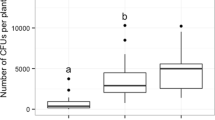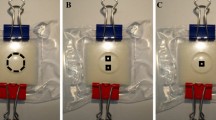Abstract
In a greenhouse and in an open field, aspects of aerial and ambulatory dispersal of the phytoseiid mite, Neoseiulus fallacis (Garman) were studied with a focus on events that would occur after aerially dispersing mites had landed on soil or associated substrates. We measured recovery of predators on lima bean plants (Phaseolus lunatus L.) that were infested with the two-spotted spider mite, Tetranychus urticae Koch. Factors thought to affect movement and colonization were distance to a receiver unit from a release (landing) point, intervening soil surfaces such as clods, gravel, fine soil and grass, and management of soil surfaces such as mulching, watering or both. In the field, the effect of distance (0.11–1.76 m) from a landing point to a receiver unit was significant, with a negative log-linear relationship. Soil surfaces such as clods and management actions such as watering with mulching allowed for more capture of predators on bean plants with prey than did other treatments. Environmental conditions greatly affected survival of N. fallacis.Predators in the field that were present on bare soil suffered high mortality (ca. 90%) at fluctuating daytime conditions of 26.4 ± 4.8°C and 56 ± 13.4% RH. Predators only suffered 10% mortality in the greenhouse under the same setting, but under more controlled and favorable environmental conditions. Effects of environmental conditions, mode of dispersal and implications to biological control are discussed.
Similar content being viewed by others
References
Bernstein, C. 1983. Some aspects of Phytoseiulus persimilis (Acarina: Phytoseiidae) dispersal behaviour. Entomophaga 28: 185–198.
Berry, J.S. and Holtzer, T.O. 1990. Ambulatory dispersal behavior of Neoseiulus fallacis (Acarina: Phytoseiidae) in relation to prey density and temperature. Exp. Appl. Acarol. 8: 253–279.
Berry, J.S. and Holtzer, T.O. 1991. Experiments using a simulation model of the Banks grass mite (Acarina: Tetranychidae) and the predatory mite, Neoseiulus fallacis (Acarina: Phytoseiidae) in a corn microenvironment. Environ. Entomol. 20: 1174–1178.
Boller, E.F., Remund, U. and Candolfi, M.P. 1988. Hedges as potential sources of Typhlodromus pyri, predatory mite in vineyards of northern Switzerland. Entomophaga 33: 247–255.
Brandenburg, R.L. and Kennedy, G.G. 1982. Intercrop relationships and spider mite dispersal in a corn/peanut agro-ecosystem. Entomol. Exp. Appl. 32: 269–276.
Coop, L.B. and Croft, B.A. 1995. Neoseiulus fallacis: dispersal and biological control of Tetranychus urticae following minimal inoculations into a strawberry field. Exp. Appl. Acarol.19: 31–43.
Croft, B.A. and Croft, M.B. 1993. Larval survival and feeding by immature Metaseiulus occidentalis, Neoseiulus fallacis, Amblyseius andersoni and Typhlodromus pyri on life stage groups of Tetranychus urticae Koch and phytoseiid larvae. Exp. Appl. Acarol. 17: 685–693.
Croft, B.A. and Coop, L.B. 1998. Heat units, release rate, prey density, and plant age effects on dispersal by Neoseiulus fallacis (Acari: Phytoseiidae) after inoculation into strawberry. J. Econ. Entomol. 91: 94–100.
Croft, B.A., Messing, R.H., Dunley, J.E. and Strong, W.B. 1993. Effects of humidity on eggs and immatures of Neoseiulus fallacis, Amblyseius andersoni, Metaseiulus occidentalis and Typhlodromus pyri (Phytoseiidae): implications for biological control on apple, caneberry, strawberry and hop. Exp. Appl. Acarol. 17: 451–459.
Drapek, R.J. 1993. Use of a geographic information system to modify pheromone trap-based predictions of Helicoverpa zea (Boddie) damage. PhD Thesis. Dept. Entomology, Oregon State University. 158 pp.
Dunley, J.E. and Croft, B.A. 1990. Dispersal between and colonization of apple by Metaseiulus occidentalis and Typhlodromus pyri (Acarina: Phytoseiidae). Exp. Appl. Acarol. 10: 137–149.
Ferro, D.N. and McNeil, J.N. 1998. Habitat management and conservation of natural enemies of insects. In: Conservation biological control, P. Barbosa (ed.), pp. 127–132. Academic Press. San Diego.
Field, R.P. and Hoy,M.A. 1985. Diapause behavior of genetically improved strain of the spider mite predator Metaseiulus occidentalis (Acarina: Phytoseiidae). Entomol. Exp. Appl. 38: 113–120.
Flexner, J.L., Westigard, P.H., Gonzalves, P. and Hilton, R. 1991. The effect of groundcover and herbicide treatment on two spotted spider mite density and dispersal in southern Oregon pear orchards. Entomol. Exp. Appl. 60: 111–123.
Helle, W. and Sabelis, M.W. 1985. Spider mites: their biology, natural enemies and control. Vol. 1B, 458 pp. Elsevier, New York.
Hislop, R.G. and Prokopy, R.J. 1981. Mite predator responses to prey and predator-emitted stimuli. J. Chem. Ecol. 7: 895–904.
Hoy, M.A. 1982. Aerial dispersal and field efficacy of a genetically improved strain of the spider mite predator Metaseiulus occidentalis. Entomol. Exp. Appl. 32: 205–212.
Hoy, M.J., Groot, J.J. and van de Baan, H.E. 1985. Influence of aerial dispersal on persistence and spread of pesticide-resistant Metaseiulus occidentalis in California almond orchards. Entomol. Exp. Appl. 37: 17–31.
Janssen, A. 1999. Plants with spider-mite prey attract more predatory mites than clean plants under greenhouse conditions. Entomol. Exp. Appl. 90: 191–198.
Janssen, A., Bruin, J., Jacobs, J., Schraag, R. and Sabelis, M.W. 1997. Predators use volatiles to avoid prey patches with conspecifics. J. Anim. Ecol. 66: 223–232.
Johnson, D.T. and Croft, B.A. 1976. Laboratory study of the dispersal behavior of Amblyseius fallacis (Acarina: Phytoseiidae). Ann. Entomol. Soc. Amer. 69: 1019–1023.
Johnson, D.T. and Croft, B.A. 1979. Factors affecting the dispersal of Amblyseius fallacis in an apple tree ecosystem. In: Recent advances in Acarology 1, J.G. Rodriguez (ed.), pp. 477–484. Academic press. New York.
Johnson, D.T. and Croft, B.A. 1981. Dispersal of Amblyseius fallacis (Acarina: Phytoseiidae) in an apple ecosystem. Environ. Entomol. 10: 313–319.
Kogan, M., Croft, B.A. and Sutherst, R.F. 1999. Applications of ecology for integrated pest management. In: Ecological entomology, 2nd ed., C.B. Huffaker and A.P. Gutierrez (eds), pp. 681–736. John Wiley & Sons, New York.
Margolies, D.C. 1987. Conditions eliciting aerial dispersal behavior in Banks Grass Mite, Oligonichus pratensis (Acari: Tetranychidae). Environ. Entomol. 16: 928–932.
McMurty, J.A. and Croft, B.A. 1997. Life-styles of phytoseiid mites and their roles in biological control. Annu. Rev. Entomol. 42: 291–321.
McMurtry, J.A. and Scriven, G.T. 1965. Insectary production of phytoseiid mites. J. Eco. Entomol. 58: 282–285.
Morris, M.A. 1998. Biological control of Tetranychus urticae (Koch) on peppermint by Neoseiulus fallacis (Garman): density relationships, overwintering, habitat manipulation and pesticide effects. PhD Thesis. Dept. Entomology, Oregon State University. 79 pp.
Nachman, G. 1987. Systems analysis of acarine predator–prey interactions. I. A stochastic simulation model of spatial processes. J. Anim. Ecol. 56: 247–265.
Nyrop, J., English-Loeb, G. and Roda, A. 1998. Conservation biological control of spider mites in perennial cropping systems. In: Conservation biological control, P. Barbosa (ed.), pp. 307–333. Academic Press. San Diego.
Pels, B. and Sabelis, M.W. 1999. Local dynamics, overexploitation and predator dispersal in an acarine predator–prey system. Oikos 86: 573–583.
Penman, D.R. and Chapman, R.B. 1980. Effect of temperature and humidity on the locomotory activity of Tetranychus urticae (Acarina: Tetranychidae), Typhlodromus occidentalis and Amblyseius fallacis (Acarina: Phytoseiidae). Acta Ecologia. 1: 259–264.
Pratt, P.D. 1999. Biological control of spider mites by the predatory mite Neoseiulus fallacis (Acari: Phytoseiidae) in ornamental nursery plant systems. PhD Thesis. Dept. Entomology, Oregon State University. 150 pp.
Pratt, P.D., Monetti, L.N. and Croft, B.A. 1998. Within-and between-plant dispersal and distributions of Neoseiulus californicus and N. fallacis (Acari: Phytoseiidae) in simulated bean and apple plant systems. Environ. Entomol. 27: 148–153.
Ramsey, F.L. and Schafer, D.W. 1996. The statistical sleuth. p. 742. Duxbury Press, New York.
Raworth, D.A., Gauvel, G. and Auger, P. 1994. Location, reproduction and movement of Neoseiulus californicus (Acari: Phytoseiidae) during the autumn, winter and spring in orchards in the south of France. Exp. Appl. Acarol. 18: 593–602.
Sabelis, M.W. and Dicke, M. 1985. Long-range dispersal and searching behavior. In: Spider mites: their biology, natural enemies and control, Vol. 1B, W. Helle and M.W. Sabelis (eds), pp. 141–160. Elsevier, New York.
Sabelis, M.W., Diekmann, O. and Jansen, V.A.A. 1991. Metapopulation persistence despite local extinction: predator–prey patch models of the Lotka–Volterra type. Biol. J. Linn. Soc. 42: 267–283.
Sabelis, M.W. and Afman, B.P. 1994. Synomone-induced suppression of take-off in the phytoseiid mite Phytoseiulus persimilis Athias-Henriot. Exp. Appl. Acarol. 18: 711–721.
Sabelis, M.W. and van de Baan, H.E. 1983. Location of distant spider mite colonies by phytoseiid predators: demonstration of specific kairomones emitted by Tetranychus urticae and Panonychus ulmi. Ent. Exp. Appl. 33: 303–314.
Sabelis, M.W. and van der Weel, J.J. 1993. Anemotactic response of the predatory mite, Phytoseiulus persimilis Athias-Henriot and their role in prey finding. Exp. Appl. Acarol. 17: 521–529.
Schausberger, P. 1998. The influence of relative humidity on egg hatch in Euseius finlandicus, Typhlodromus pyri and Kampimodromus aberrans (Acari, Phytoseiidae). J. Appl. Ent. 122: 497–500.
Schausberger, P. and Croft, B.A. 2000. Intraguild predation and cannibalism among generalist and specialist phytsoseiid mites: nutritional benefits. Ecol. Entomol. (in press).
Smitley, D.R. and Kennedy, G.G. 1985. Photo-oriented aerial dispersal behavior of Tetranychus urticae (Acari: Tetranychidae) enhances escape from the leaf surface. Ann. Entomol. Soc. Am. 78: 609–614.
Strong, W.B. and Croft, B.A. 1995. Inoculative release of phytoseiid mites (Acarina: Phytoseiidae) into the rapidly expanding canopy of hops for control of Tetranychus urticae (Acarina: Tetranychidae). Environ. Entomol. 24: 446–453.
Strong, W.B., Slone, D.H. and Croft, B.A. 1999. Hops as a metapopulation landscape for tetranychid–phytoseiid interactions: perspectives of intra-and interplant dispersal. Exp. Appl. Acarol. 23: 581–597.
Tixier, M.S., Kreiter, S., Auger, P. and Weber, M. 1998. Colonization of Languedoc vineyards by phytoseiid mites (Acari: Phytoseiidae): influence of wind and crop environment. Exp. Appl. Acarol. 22: 523–542.
Author information
Authors and Affiliations
Rights and permissions
About this article
Cite this article
Jung, C., Croft, B.A. Survival and plant-prey finding by Neoseiulus fallacis Neoseiulus fallacis (Acari: Phytoseiidae) on soil substrates after aerial dispersal. Exp Appl Acarol 24, 579–596 (2000). https://doi.org/10.1023/A:1026593907917
Issue Date:
DOI: https://doi.org/10.1023/A:1026593907917




